 Scaling Up and Out:
Scaling Up and Out:
Balancing Technical and Operational Needs
Traditionally, scale-up of biopharmaceutical manufacturing has been a straightforward process: Makers of protein products would perform cultures in flasks and roller bottles to grow enough cells to inoculate laboratory-scale (often glass) bioreactors, then again to pilot- and commercial-scale stainless-steel stirred-tank bioreactors, the latter handling potentially tens of thousands of liters of cells and growth media. If a drug developer did not have the requisite equipment to scale up, it leveraged the bioreactor capacity of a contract manufacturing organization (CMO). But production strategies have changed significantly during the past ten — and even five — years. Process improvements, novel cell-culture technologies, effective single-use components, and innovations in continuous biomanufacturing now enable biopharmaceutical companies to scale out processes of intermediate production volumes instead of pursuing maximum volumes in stainless steel. Technologies for production of advanced therapies are experiencing similar gains, such that developers of such products now can consider scaling up to suspension culture systems. This featured report explores the newfound possibilities and complexities of scalability strategy.
 Antibody Derivatives:
Antibody Derivatives:
Fusions, Fragments, and Multiplex Modalities
Monoclonal antibodies (MAbs) remain the dominant biopharmaceutical product class, but as biotechnologies have advanced in recent decades, developers have found ways to exploit their “magic-bullet” capabilities while putting aside their limitations. That has led to a new generation of antibody-related therapeutics created by cutting and pasting molecular domains. Researchers are mixing and matching functional moieties of antibodies and other molecules to create custom-designed proteins with powerful efficacy and tunable targeting. Many avenues have been pursued to improve on the monoclonal antibody paradigm, leading to development of new monoclonals and antibody-derived therapeutic proteins. Derivatives include modified intact antibodies with modulated effector functions, bispecific and multispecific antibodies, and antibody fragments. In this featured report, BPI contributes to the expanding literature of antibody fragments and fusions with a review of recent literature followed by a discussion of bispecifics in development and two technical reports related to fragments and fusion proteins. Additions from BioProcess Insider add perspectives from Zymeworks and Lonza.
 Intelligent Biomanufacturing:
Intelligent Biomanufacturing:
Linking Data with Product Quality
Intelligent manufacturing or “Biomanufacturing 4.0” is the implementation of digitalization, digital platforms, real-time monitoring and control, predictive technologies, and other data-driven tools such as machine learning (ML) and artificial intelligence (AI) to advance process and product knowledge and understanding. The information gained from those strategies can help drug developers design their processes to enhance product quality and optimize their operations. Most industry experts agree that the tools for this “next generation” of biomanufacturing will take time for widespread adoption, but such strategies will need to in place to meet the process and capacity requirements of future complex biologics. In this report, authors from the Alliance for Artificial Intelligence focus on the approaches they use to process large amounts of data (“big data”) and how the knowledge of different types of data can be used to train model parameters. Authors from Haynes Boone highlight the advantages of using AI and the intellectual property implications of AI-created inventions in the biopharmaceutical industry. And authors from Bayer discuss the application of digital twins, ML, predictive analytics, and software platforms for a viral clearance process and suggest future work in cloud implementation.
 Optimizing Viral Vectors: Production, Processing, Delivery
Optimizing Viral Vectors: Production, Processing, Delivery
Biopharmaceutical developers and manufacturers are augmenting their cell and gene therapy (CGT) capabilities in response to promising clinical data, high demand for novel treatment approaches to rare diseases, and significant commercial milestones achieved by currently marketed products. However, manufacturing the viral vectors required to deliver such therapies remains complex, cost-prohibitive, and inefficient. This issue’s featured report describes barriers that continue to hinder production of viral vectors despite the rapid clinical development of therapies based upon them. The authors and contributors included herein also highlight potential solutions such as careful selection of raw materials for associated cell-culture operations, improvements to transfection reagents and processes, increased implementation of suspension cell-culture systems, improved understanding of mechanisms for vector immunogenicity, and aseptic technologies for combined formulation and fill–finish steps.
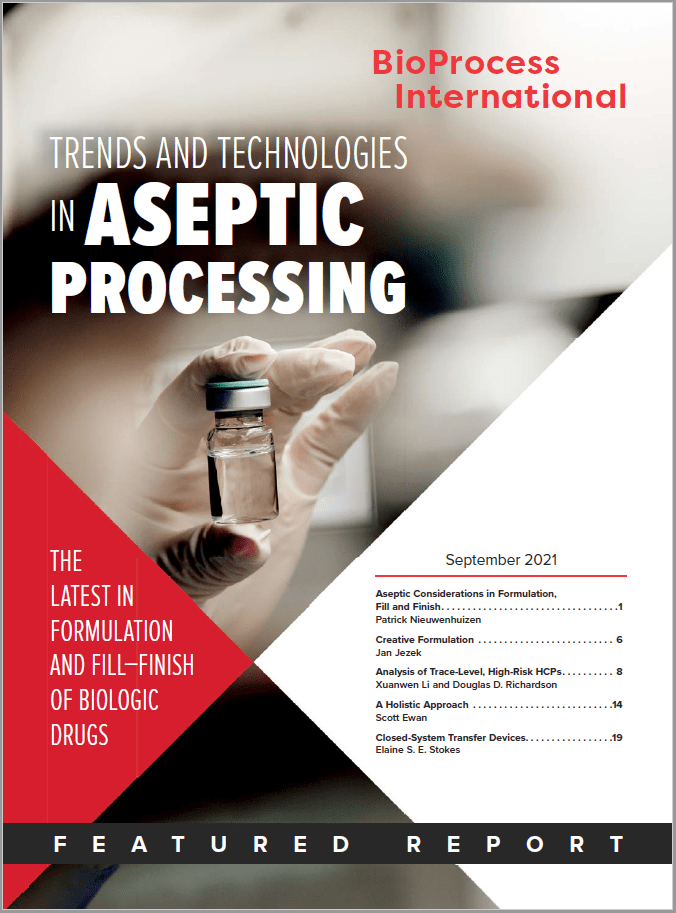 Trends and Technologies in Aseptic Processing
Trends and Technologies in Aseptic Processing
Biopharmaceutical manufacturing concludes with mixing a drug substance into a formulation that can be injected or otherwise introduced to patients — then filling and packaging the resulting drug product for delivery and distribution. Aseptic processing is key to making sure that biologic drugs are safe for patients. From buffers and excipients to containers and closures to specialized devices, this featured report centers on biopharmaceutical drug products and the types of controls used to ensure their quality, safety, and efficacy. The authors compare the utility of isolator and barrier technologies, describe patient-centered approaches to formulation development, introduce novel techniques for identifying and managing polysorbate degradation in biological products, and chronicle industry-wide developments in testing container closures and closed-system transfer devices.
 BPI Theater at the BIO International Convention, 2021
BPI Theater at the BIO International Convention, 2021
Due to the continuing COVID-19 pandemic, the BPI Theater delivered interviews and presentations digitally during the 2021 BIO International Convention. Centering the presentations around two key themes — emerging therapies and technologies — enabled the theater speakers and attendees to engage complex, interconnected topics that are of interest to BPI readers. Speakers highlighted how their companies are responding to both challenges and opportunities relating to manufacturing technique and capacity, particularly where it concerns expressing and mass-producing novel proteins. The presenters also reflected on how far the biopharmaceuticals industry has come, the challenges it faces with COVID-19, and where it can go in the age of individualized cell and gene therapies.
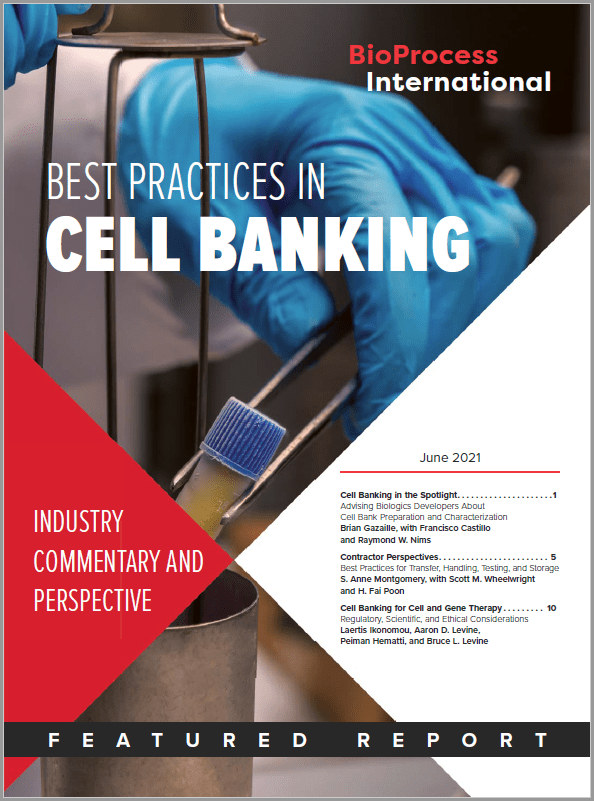 Best Practices in Cell Banking:
Best Practices in Cell Banking:
Industry Commentary and Perspective
Living cells are at the heart of biotechnology, and cell lines for production and testing of biopharmaceuticals are highly valuable assets. The process of banking cells generally moves from development of a research cell bank (RCB) based on a clone of interest to establishment of a master cell bank (MCB), from which working cell banks (WCBs) can be produced. Especially for biotechnology startups, preparation and characterization of an MCB can involve a significant jump from work performed in standard laboratory conditions to good manufacturing practice (GMP)-compliant operations. For such reasons, biopharmaceutical developers usually delegate MCB preparation to contract development and manufacturing organizations (CDMOs). This featured report explores some of the processes that go into ushering cell banks from their earliest forms to those that enable GMP production of biologics. Read the articles below to learn about cell banking best practices gathered from biopharmaceutical developers, contract manufacturers, academic researchers, and industry consultants.
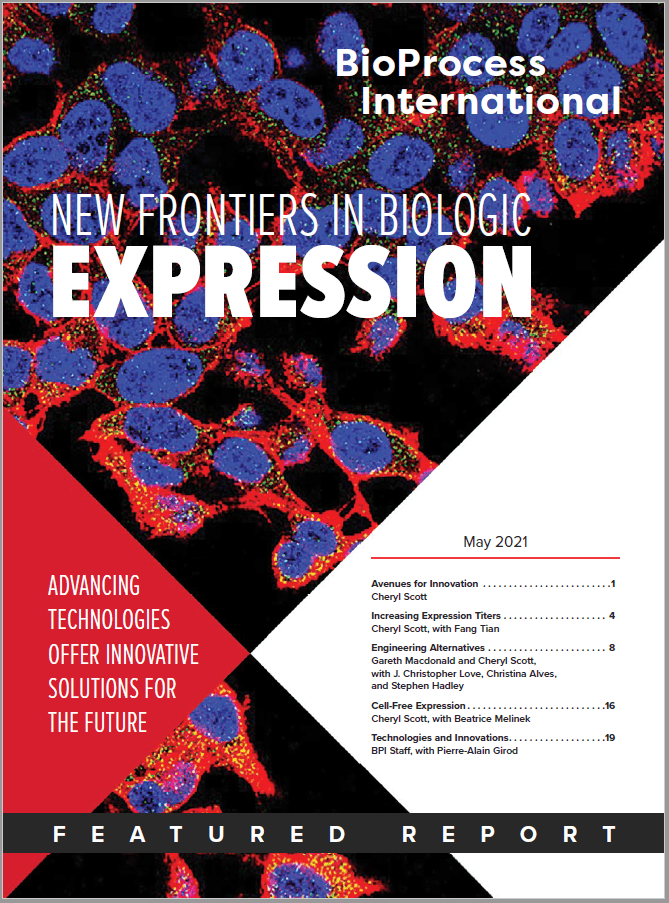 New Frontiers in Biologic Expression: Advancing Technologies Offer Innovative Solutions for the Future
New Frontiers in Biologic Expression: Advancing Technologies Offer Innovative Solutions for the Future
Already undergoing a revolution in speed and bioengineering capabilities, the discipline of biological expression is beginning to assess options that previously were considered “for research purposes only” as real candidates for bioprocessing. Scientists at the American Type Culture Collection (ATCC) are among several organizations that are engineering cell lines for improved expression of high-titer biologics that fulfill well-defined critical quality attributes (CQAs) for product safety and efficacy. A new industry–academia consortium seeks to bring forth not only viable but superior alternatives to Chinese hamster ovary (CHO) cell expression systems. And other researchers are working to create cell-free production systems that might one day disrupt the entire concept of upstream production. Read the articles in this BPI Featured Report to learn how the biopharmaceutical industry is leveraging emerging and underexplored protein-expression systems to treat myriad conditions.
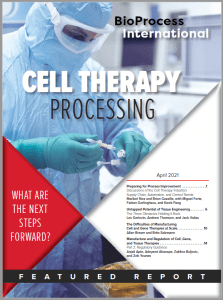 Cell Therapy Processing:
Cell Therapy Processing:
What Are the Next Steps Forward?
Cell and gene therapy (CGT) innovators are focusing on increasingly complex diseases and indications. The preference for off-the-shelf allogeneic products is still present, but developers also are not shying away from providing autologous products exclusively. Although most CGT companies have established processes, they still depend heavily on manual operations and single-source supply chains. Thus, companies continue to seek out technologies that can make cell therapy processing better and faster. As the number of cell therapy clinical trials increases, such technologies will need to be automated and scalable. Equally important, manufacturers will need better control of their processes and better assurance of their supply chains. Articles in this featured report identify key areas of need for cell therapy processing. Read the articles below to learn more about the obstacles that cell therapy manufacturers are facing as a result of rapid growth, the COVID-19 pandemic, and lack of standardization.
 Assay Development:
Assay Development:
Establishing and Tracking Quality of Biologics
Assay development is foundational to the well-characterized biotechnology product paradigm. Bioassays are the best tools for drug developers to use in determining the biological activity (potency) of their products, which has been a biopharmaceutical critical quality attribute (CQA) since long before that concept had a name. Thus, these assays are vital to quality assurance and quality control (QA/QC), preclinical studies, and clinical testing — and by extension to process development and monitoring. Yet because of their complexity, bioassays are among the most challenging experiments to perform reliably with dependably accurate results. Consistency requires a controlled environment and qualified reagents, skilled analysts, and assay protocols that are intelligently developed, characterized, and validated. Depending on the use of a method, it could be required to comply with good laboratory practice, good clinical practice, or good manufacturing practice (GxP) regulations as well as electronic data security. This featured report explores how emerging technologies, including systems that enable automation, simultaneously could facilitate and complicate bioassay development and execution.
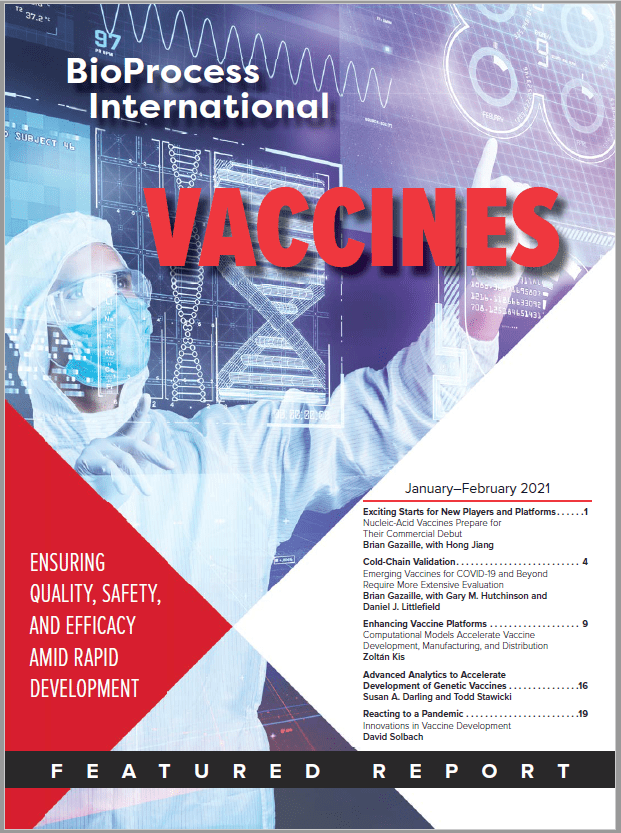 Vaccines: Ensuring Quality, Safety,
Vaccines: Ensuring Quality, Safety,
and Efficacy Amid Rapid Development
Speed has been critical to development, regulatory approval, and mass manufacture of vaccines against the SARS-CoV-2 coronavirus. That speed comes in part from emerging genetic vaccines based on messenger RNA (mRNA), plasmid DNA, and viral vectors. Such products depend on delivery and uptake of a select part of a pathogen’s genetic sequence. Thus, they eliminate the risk and complexity of working with live viruses. More important, genetic vaccines enable development of scalable platform processes. That capability could facilitate rapid development and manufacture of low-cost vaccines for scores of illnesses besides COVID-19 and for under-resourced populations with currently unmet medical needs. However, to realize such possibilities, vaccine companies will need to balance speed with product safety, efficacy, quality, and stability. This featured report explores the manufacturing advantages and challenges of emerging genetic vaccines as well as technologies and infrastructures that the biopharmaceutical industry needs to implement to deliver on their vast potential.
 Optimizing Processes for Gene Therapies
Optimizing Processes for Gene Therapies
Development of gene therapies and gene-edited cell therapies has made significant progress in the past decade. Some processing challenges remain, however. Specifically, purification of viral vectors (lentivirus in the case of ex vivo therapies and adenoassociated virus (AAV) for in vivo products) is a complex process because titers are small compared with those of traditional biopharmaceuticals. Moreover, contaminant removal requires multiple filtrations. Such challenges ramp up process costs and extend timelines. Consequently, biomanufacturers need to optimize and streamline their processes. In this Featured Report, BPI’s managing editor presents highlights from the gene therapy tracks at the Cell and Gene Commercialization conference. Authors from PharmaLex focus on manufacturing challenges and regulation issues of advanced-therapy medicinal products (ATMPs), including those raised when reducing chemistry, manufacturing, and controls (CMC) timelines. Authors from BIA Separations (Sartorius) present an approach for simplifying the purification of AAV drug products. And authors from Charles River Laboratories present findings from a study using analytical ultracentrifugation for recombinant AAV therapies.
 MAbs: A 2020 Update—
MAbs: A 2020 Update—
Making MAbs for COVID-19 and Beyond
Still the largest sector of the biopharmaceutical industry, monoclonal antibodies (MAbs) have an impressive history and a bright future. Authors in this featured report address process advancements, manufacturing capacity, and MAb product development for COVID-19 and G-protein–coupled receptors. The coronavirus pandemic has challenged a typically careful and deliberate approach to MAb development and disrupted supply chains for development and manufacturing — not only for those antibodies deemed most promising a year ago, but also others that have been thrust into the spotlight as potential COVID-19 treatments. Authors in this report highlight some of those candidates as well as others with antibody–drug conjugate (ADC) potential against a “new” class of targets. Articles herein also elucidate the current state of manufacturing capacity for the MAb industry. Here you’ll find an update on the MAb landscape as this anomalous year begins to draw to a close with all too few answers to many questions that have arisen over the past several months.
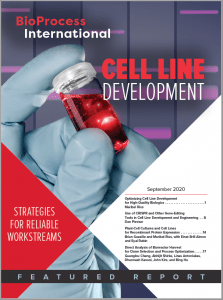 Cell Line Development:
Cell Line Development:
Strategies for Reliable Workflows
Achieving favorable product quality attributes begins with optimizing cell line development, including the early identification and proper selection of a clone. Biomanufacturers are working toward higher yields and improved cell quality by using high-throughput screening methods and advanced gene editing methods. This featured report focuses on different factors of cell line development quality and how they affect the quality of a final drug product.
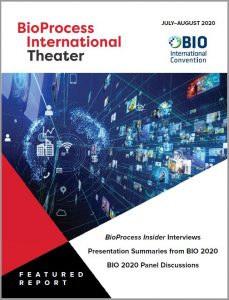 BioProcess International Theater at BIO 2020
BioProcess International Theater at BIO 2020
Follow this link to find presentations from BPI Theaters that took place virtually from June 8–11 during the 2020 BIO International Convention. Centering the presentations around two key themes — emerging therapies and technologies — enabled theater speakers and attendees to engage complex, interconnected topics that are of interest to BPI readers. Speakers highlighted how their companies are responding to both challenges and opportunities relating to manufacturing technique and capacity, particularly where it concerns expressing and mass-producing novel proteins. Presenters also reflected on how far the biopharmaceuticals industry has come since its beginnings, the challenges that industry will face during and after the COVID-19 pandemic, and where bioprocessing can go in the age of individualized cell and gene therapies.
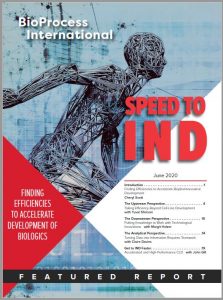 Speed to IND: Finding Efficiencies to Accelerate Development of Biologics
Speed to IND: Finding Efficiencies to Accelerate Development of Biologics
Biopharmaceutical companies seeking to move their product candidates into clinical testing as soon as possible face several challenges. Tackling the chemistry, manufacturing, and controls (CMC) section of the investigational new drug (IND) application requires due diligence and a commitment to quality and safety. Efficiency comes into play when speed to IND is the goal. In this featured report, experts in upstream and downstream processing, analytical support, and cell-line development discuss how teams can work together to advance their projects as quickly and cost-effectively as possible without compromising vital criteria.
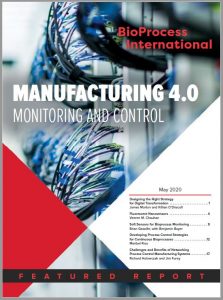 Manufacturing 4.0: Monitoring and Control
Manufacturing 4.0: Monitoring and Control
Manufacturing 4.0 emphasizes obtaining and using data to gain knowledge about processes and product quality. Essential tools and technologies in this process environment focus on digitalization and process monitoring and control. In this report, BPI’s managing editor joins authors from Austria’s University of Natural Resources and Life Sciences (BOKU), Boston Consulting Group, Ireland’s National Institute for Bioprocessing Research and Training (NIBRT), and the United Kingdom’s University of Nottingham to explore strategies for hastening Manufacturing 4.0. Read on to learn more about the role of enterprise resource planning (ERP) systems in digitalization strategy, novel soft sensors and fluorescent nanosensors for real-time monitoring of bioprocess parameters, and advanced process control systems.
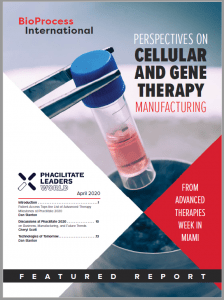 Perspectives on Cellular and
Perspectives on Cellular and
Gene Therapy Manufacturing:
From Advanced Therapies Week in Miami
As part of part of Advanced Therapies Week in Miami, FL, alongside the World Stem Cell Summit this past January, the 2020 Phacilitate Leaders World event was one of the last major biotechnology conferences to take place as planned in 2020 before the coronavirus pandemic changed everything. BPI was a major partner at this event, and in this month’s featured report, we highlight the aspects of the conference that will be of greatest relevance to our readers.
BioProcess Insider and BioProcess International editors come together to report on what can best be characterized as a “reality check” for the cell and gene therapy industry. While financing flows in, companies are facing questions over how best to spend that money. Manufacturability issues continue, quality control challenges remain, and investors want to see results now. Even before COVID-19 introduced a new layer of difficulty, the industry was juggling a number of concerns and suffering from some growing pains. The articles below will give you a snapshot of this business on the brink of greatness.
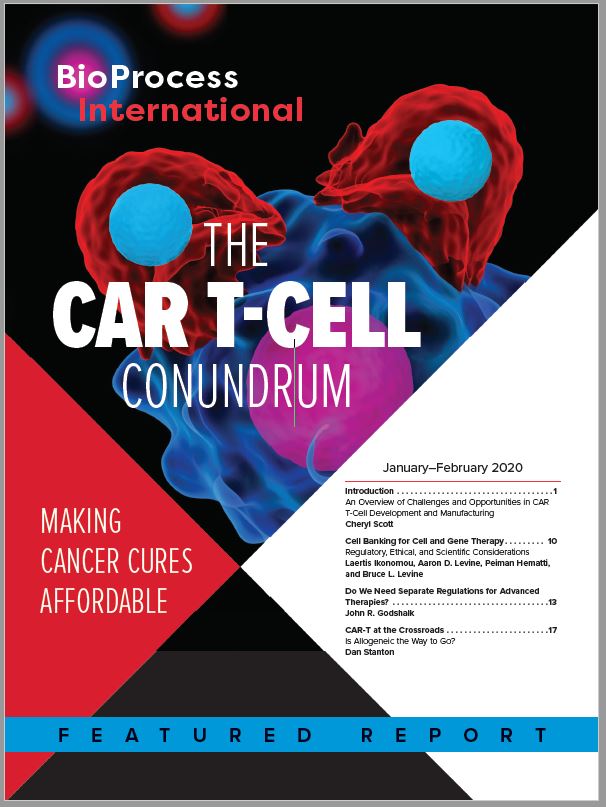 The CAR T-Cell Conundrum
The CAR T-Cell Conundrum
Regenerative medicine evolved from medical research rather than from drug-development companies, and technologies that worked in clinical settings haven’t translated directly to large-scale manufacturing. Cost is often the problem for chimeric antigen receptor (CAR) T-cell therapies. And whereas the classical drug field increasingly is called out for massive mark-ups and huge advertising budgets, the price of regenerative medicines truly is linked directly to the cost of making them. This month’s Featured Report gathers industry perspectives on the status of the “CAR-T conundrum,” exploring what it will take for those promising new therapies to become affordable and accessible to patients. Read on to learn about challenges that remain with CAR-T manufacturing, discussions surrounding the need for distinct regulatory requirements for advanced therapy production, recent developments in CAR-T commercialization, and the escalation of private cell-banking abuse.
 Production and Analysis of Gene Therapies
Production and Analysis of Gene Therapies
The number of gene therapies in different stages of clinical trials is increasing, driving the need for innovative process and analytical strategies. Viral vectors (e.g., adenoassociated viruses and lentiviruses) are used for delivery of gene therapies, so their production and purification are critical for the success of gene therapies. In this featured report, authors project future capacity needs for viral vectors and discuss the importance of selecting the best platform for their manufacture and scalability. Authors also discuss approaches for assay development and testing strategies.
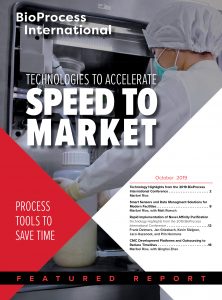 Technologies to Accelerate Speed to Market
Technologies to Accelerate Speed to Market
Biomanufacturers are leveraging different solutions for compressing timelines to commercialization, including constructing efficient facility designs and implementing rapid manufacturing strategies. Alongside these approaches are the technologies and innovations being used at all process stages and scales. Biomanufacturing equipment suppliers have developed advanced process tools to meet the requirements for ever-decreasing times to market. This report presents some of those advancements.
Cell Line Development:
From Genome Editing to Media Adaptation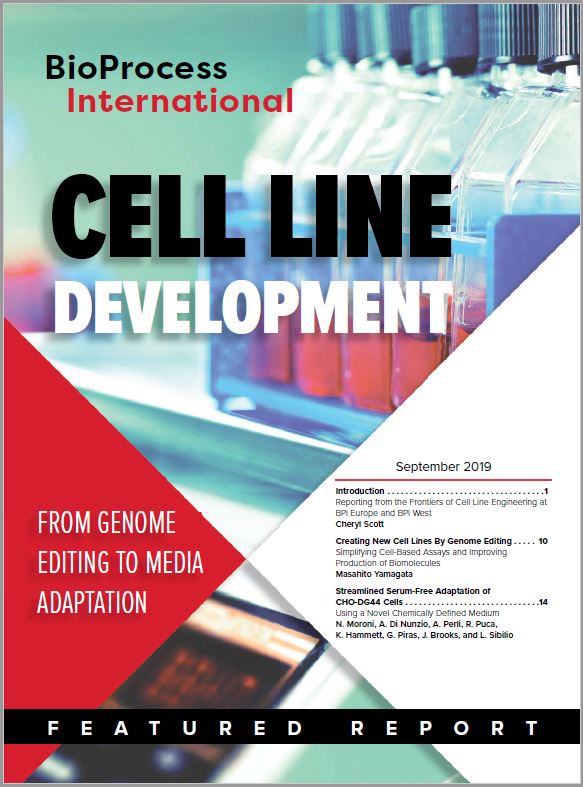
Cell-line development is more than just bioengineering. Every biomanufacturing process begins with transfection of recombinant genes into pools of cells — followed by a succession of screenings from which will emerge (ideally) a single progenitor cell of the new production cell line. But clonality is only part of the story. In this month’s featured report, we examine the latest advances in science and technology for transfecting, picking, screening, and adapting cell lines to the ideal conditions for producing therapeutic biomolecules as rapidly as possible. From new product modalities and biosimilars to continuous processing and serum-free media, the demands are high and the results can be rewarding.
Large-Scale Capacity Strategy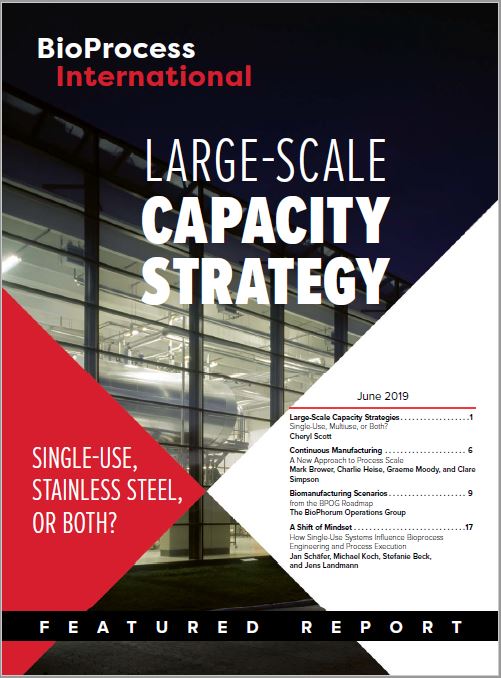
The biopharmaceutical industry is undergoing a paradigm shift in manufacturing. At the core of this evolution are definitions of scale and materials of construction. Options that at first seem mutually exclusive — multiuse, cleanable equipment based on stainless steel and single-use disposable equipment based on polymer films — actually could complement each other in combination approaches to large-scale manufacturing. In this featured report, authors from user and supplier companies review a number of strategies available for innovators and biosimilar developers making antibodies and their derivatives, other proteins, vaccines, gene and cell therapies, and beyond for the global biopharmaceutical market of the future.
Antibody Drug Conjugates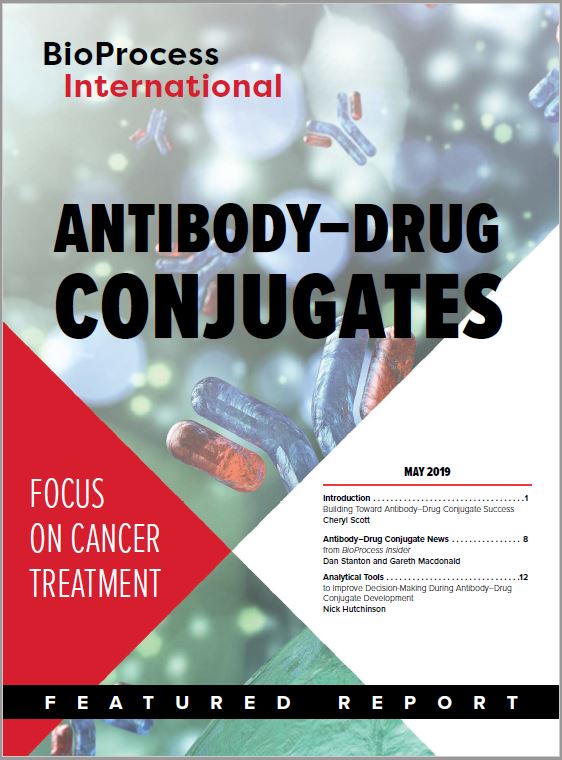
Cancer treatment is the primary application, so far, of antibody–drug conjugate product development. Lessons learned here will help companies expand this product modality into other areas. Authors in this featured report seek to characterize the current state of the ADC industry, science, and technology with an eye toward the future. They focus on process/manufacturing and product development issues, highlighting successes so far and potential for the future.
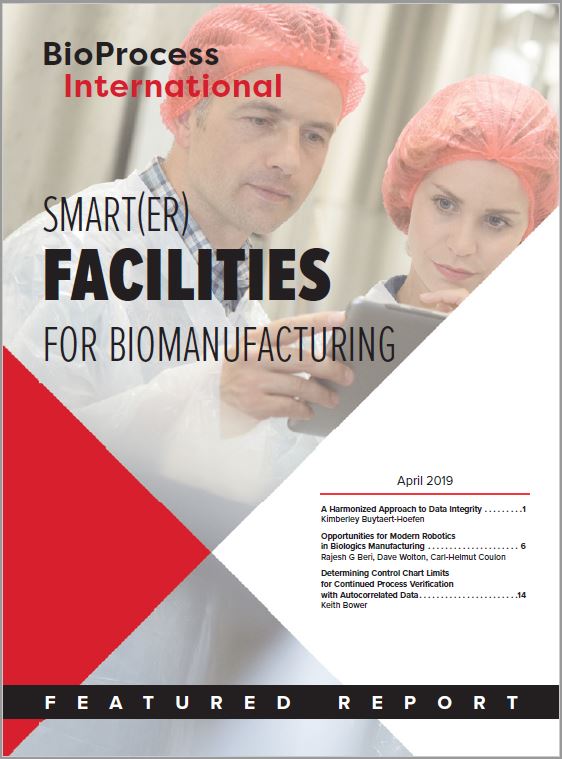 Smart(er) Facilities for Biomanufacturing
Smart(er) Facilities for Biomanufacturing
Forward-looking biomanufacturers continue to explore innovative strategies and new technologies to modernize their facilities. Leading-edge technologies in the Industry 4.0 evolution include smart sensors, predictive analytics, internet of things (IoT), cloud computing, digital twin simulations, and data lakes. In the featured report, Buytaert-Hoefen focuses on the key elements of data integrity. With assistance from the BioPhorum Operations Group, Beri et al. present one of the first discussions on the applications of robotics in bioprocessing. And Bower provides a new analysis of control chart limits and autocorrelation of data for continued process verification.
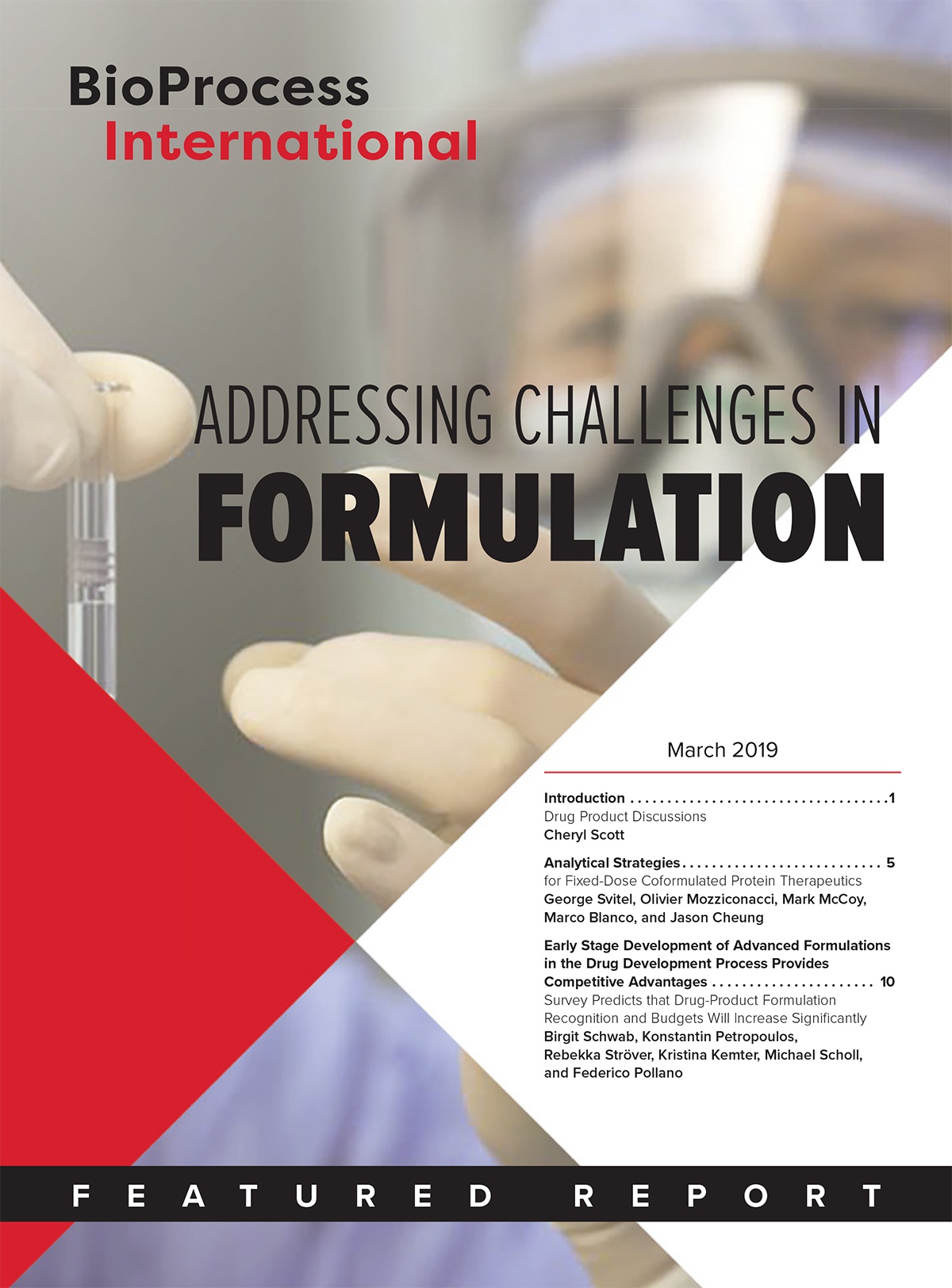 Addressing Challenges in Formulation
Addressing Challenges in Formulation
Formulation increasingly is recognized as a crucial component in drug-product success. In this month’s featured report, Rentschler authors report on the results of a recent survey and case studies that elucidate the current state of the art; Merck authors describe analytical approaches to coformulated products, and BPI’s senior technical editor shares discussions on drug-product development with past authors and BPI conference presenters.
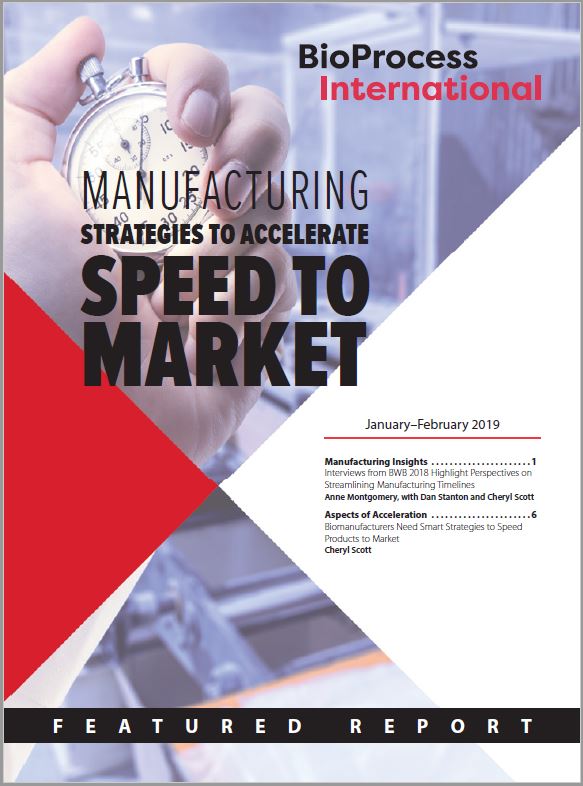 Manufacturing Strategies to Accelerate Speed to Market
Manufacturing Strategies to Accelerate Speed to Market
Addressing manufacturing and technologies strategies to accelerate market entry is one of BPI’s highlighted themes for 2019. In partnership with our conference colleagues in Informa’s KNect365 division, this already has been a shared theme, reflecting the general goals of the industry and related advice from its regulators.
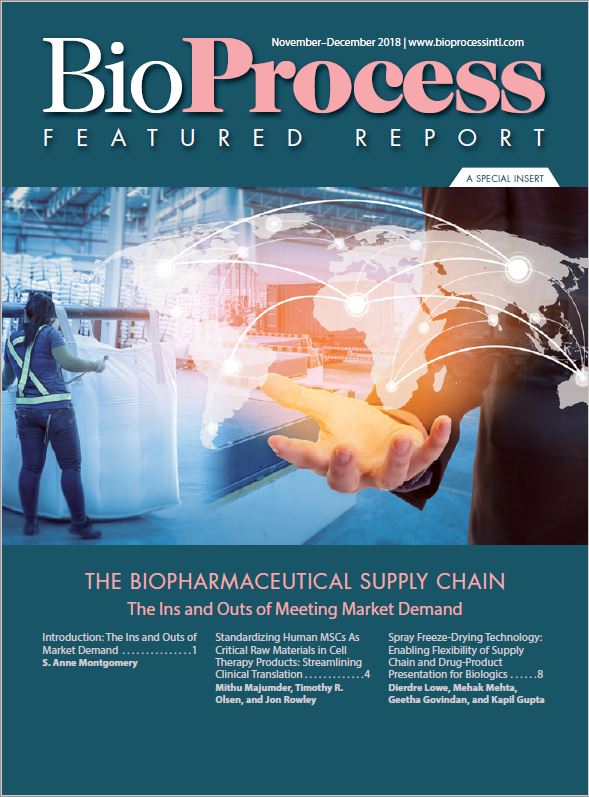 Biopharmaceutical Supply Chain: The Ins and Outs of Meeting Market Demand
Biopharmaceutical Supply Chain: The Ins and Outs of Meeting Market Demand
From procurement and quality control of raw materials to distribution and safety of final products, the supply chain provides a framework within which process development, manufacturing, testing, and sales of biopharmaceuticals can function. This featured report includes articles from both sides of the story: from RoosterBio on stem cells as raw materials and from Biogen on final product stability.
 Bioassays: Technologies and Strategies for Optimization of Advanced Product Modalities
Bioassays: Technologies and Strategies for Optimization of Advanced Product Modalities
Bioassays are critical and essential components of ensuring the safety, potency, and efficacy of biologics. Designing an appropriate bioassay can take several weeks, even months to develop and validate. New platform technologies, statistical methods, and regulatory strategies are needed to improve development. The authors in this featured report on a novel high-throughput hepatoxicity screening method, a statistical approach to assessing bioassay variations, and an approach to characterizing bioactivity assays for antibody-drug conjugates.
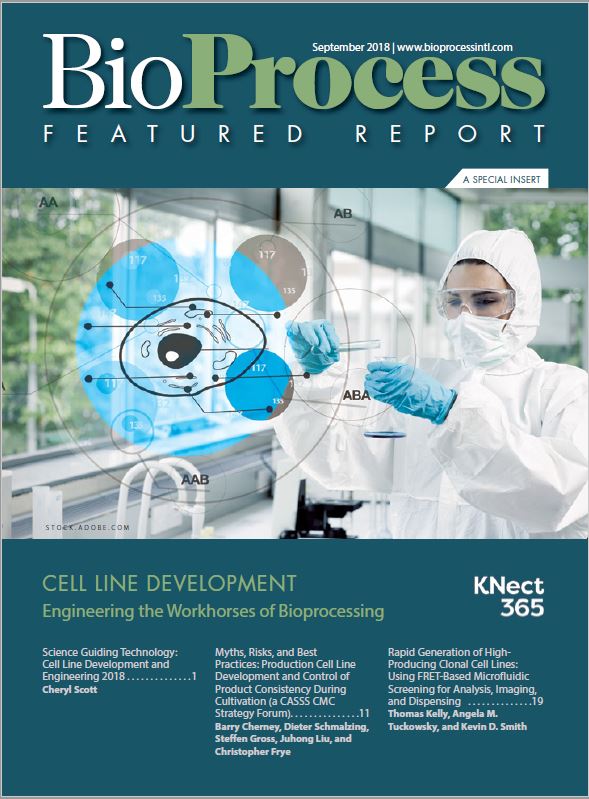 Cell Line Development: Engineering the Workhorses of Bioprocessing
Cell Line Development: Engineering the Workhorses of Bioprocessing
Advances in cell biology and associated technologies — from genetic engineering and nanotechnology to automation and data management — are changing the face of cell-line development in the biopharmaceutical industry. Seeing what’s possible, regulators are asking for more precision and better documentation on production cell lines than ever before. With an ever-intensifying desire for lowering the costs of development and manufacturing while speeding the progress of every biological candidate to market (or failure), companies are making new demands on their cell-line development groups to bring forth powerful, stable, high-expressing, and optimized cell banks as soon as possible. This featured report reviews the current state of the art of cell-line development, reports on recent discussions among experts in the field, and includes one specific case study illustrating some of the advancements being made.
 BioProcess Theater at BIO 2018
BioProcess Theater at BIO 2018
Summaries and full videos of presentations, interviews, and panel discussions that took place at the BPI Theater @ BIO 2018. Focusing on emerging therapies and technologies enabled us to touch upon interconnected topics of interest to both BPI readers and the BIO exhibit-hall attendees. Speakers highlighted new manufacturing techniques that will enable faster speed to market for cell therapies, and flexible manufacturing environments to rapidly shift and produce a variety of biotherapeutic products at clinical and commercial scale. Read the summaries that appeared in our August 2018 Featured Report, and view the full presentation videos.
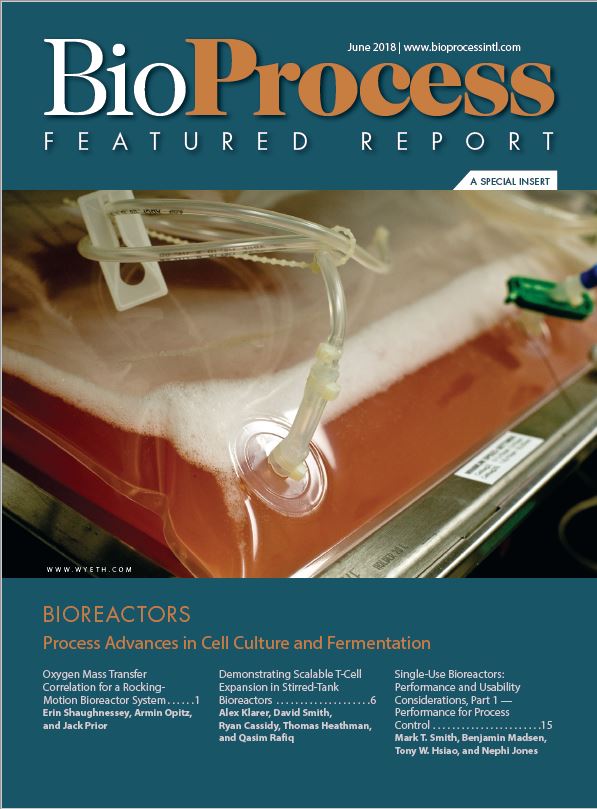 Bioreactors: Process Advances in Cell Culture and Fermentation
Bioreactors: Process Advances in Cell Culture and Fermentation
Achieving drug products that meet purity, efficacy, and quality standards depends first on cell culture quality and bioreactor performance. New analytical approaches, next-generation therapies, and innovative strategies for culture systems using a range of bioreactor types have led to a better understanding of upstream processes while reducing biopharmaceutical process/development time and costs.
 Smart(er) Facilities: Automation and Innovation Can Take Bioprocessing to the Next Level of Intelligence
Smart(er) Facilities: Automation and Innovation Can Take Bioprocessing to the Next Level of Intelligence
Today’s biomanufacturers need to be able to add capacity and capability quickly; provide increased supply service to customers on demand; and streamline the flows of personnel, traffic, utilities, and materials throughout bioprocess facilities. Companies need to be flexible enough to subtract capacity and retool quickly to produce new or different products. Future facilities are likely to be automated to some extent and use robotics in manufacturing. With personalized medicine on the rise, bioprocessors can benefit from colocation with academic research centers, laboratories, and clinics. Biofacilities should be designed to affect the environment as minimally as possible. And they would do well to be built with employees’ comfort in mind and serve as good neighbors in their local communities. It all comes down to a “smarter” approach. This featured report begins with a staff-written review, then includes end-user perspectives and supplier insights.
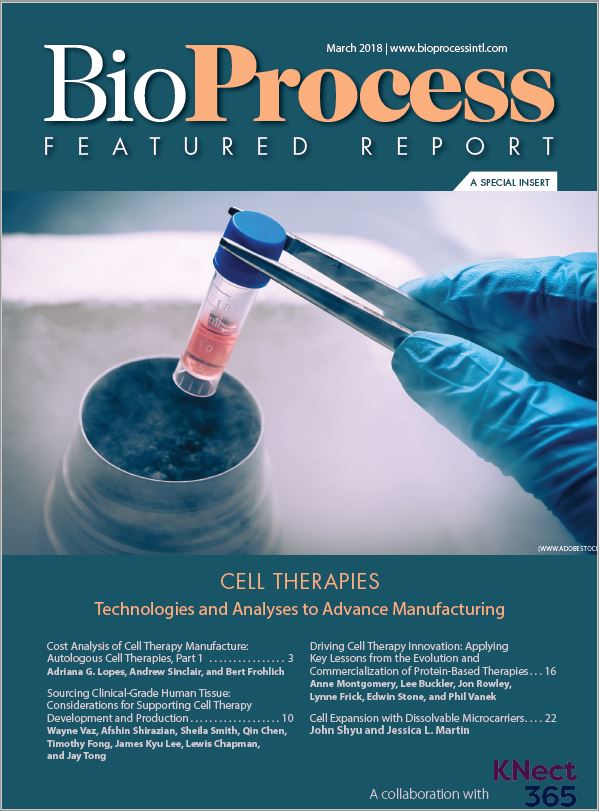 Cell Therapies: Technologies and Analyses to Advance Manufacturing
Cell Therapies: Technologies and Analyses to Advance Manufacturing
With several products in late-stage development, regenerative medicine is going mainstream. Even as some regulatory and manufacturing challenges are met, others arise. Expert contributors address topics such as supply chain and regulatory risk, cell culture technologies, economic considerations in cell therapy manufacturing, and manufacturing innovation lessons that can be derived from existing protein-based therapeutics.
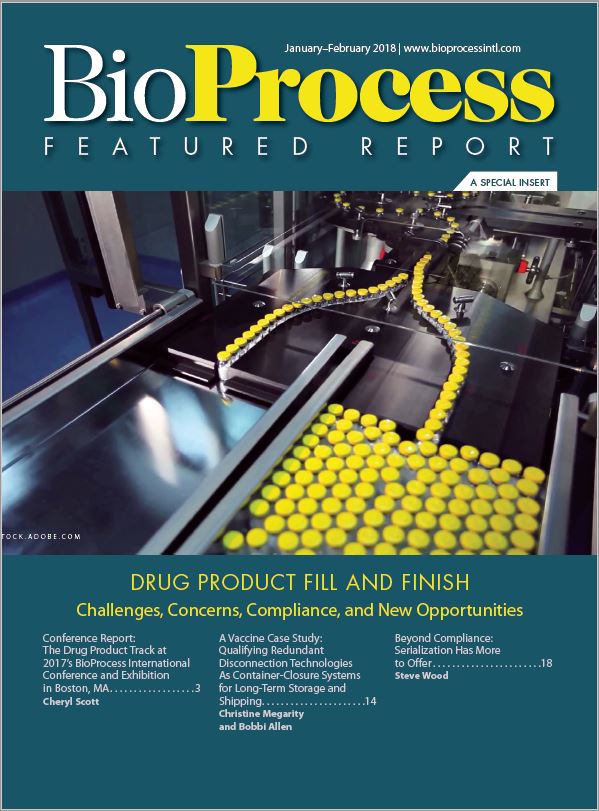 Drug Product Fill and Finish: Challenges, Concerns, Compliance, and New Opportunities
Drug Product Fill and Finish: Challenges, Concerns, Compliance, and New Opportunities
Mainly based on the Drug Products track at the 2017 “BioProcess International Conference and Exhibition” in Boston, this report also includes a submitted case study and discussions from users and suppliers of fill–finish technology. BPI’s senior technical editor reports on the conference track. Presentations focused on predictive modeling, quality by design and process analytics, freezing–thawing and storage, endotoxin control, single-use technologies, analytics, and formulation. In addition, a new Pfizer case study examines single-use solutions for freeze–thaw of a vaccine. And experts address serialization, anticounterfeiting, and streamlining fill–finish operations.
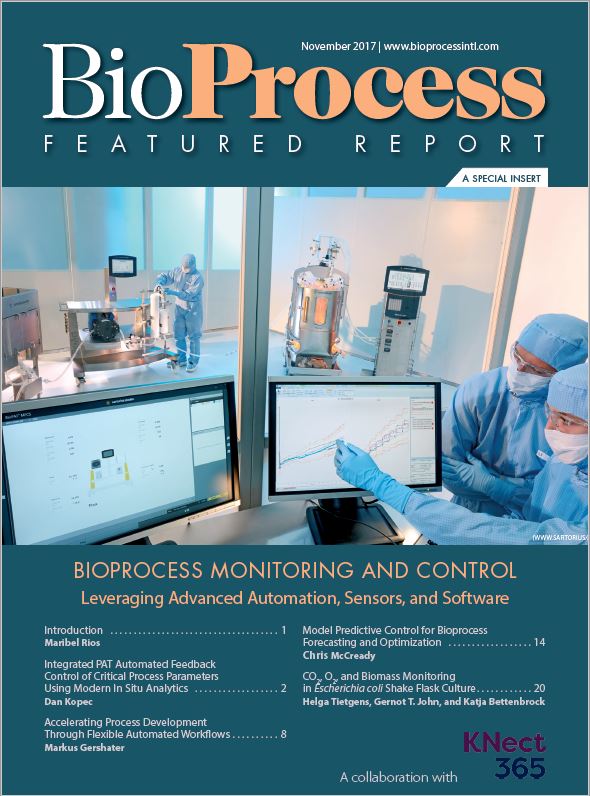 Bioprocess Monitoring and Control: Leveraging Advanced Automation, Sensors, and Software
Bioprocess Monitoring and Control: Leveraging Advanced Automation, Sensors, and Software
The need for advanced control strategies for bioprocessing and biomanufacturing is growing, and several manufacturers already have leveraged new automation and software solutions for bioprocess monitoring and control. In this Featured Report, authors discuss new approaches for process control that make use of increased computational power; advanced sensors, probes, and sampling technologies; and new software systems that can be applied to a wide range of operational modes (e.g., perfusion, continuous, and multicolumn platforms). Such technologies can be applied with single-use systems and within PAT and “machine learning” applications.
 Bioprocess Training: Strengthening Preparation for Biopharmaceutical Careers
Bioprocess Training: Strengthening Preparation for Biopharmaceutical Careers
This featured report continues BPI’s annual focus on biomaufacturing training by introducing some programs through which industry and academia are extending science to the production floor. After an introduction from NC State University’s Biomanufacturing Training and Education Center, articles from the United Kingdom (University College London) and the Netherlands (the Biotech Training Facility) describe two different approaches. The final article describes a collaborative program driven by a US government initiative that brings together many different perspectives from industry, academia, and beyond.
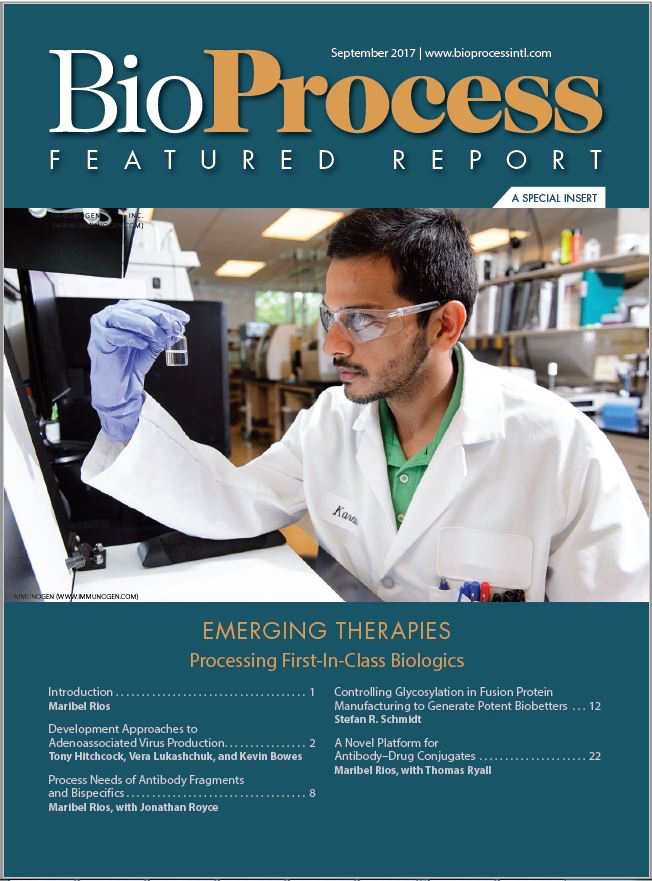 Emerging Therapies: Processing First-in-Class Biologics
Emerging Therapies: Processing First-in-Class Biologics
According to a 2017 industry report, 74% of biopharmaceuticals currently in development (phase 1–3) are possible first-in-class medicines. They include regenerative medicines, conjugated monoclonal antibodies (MAbs), and DNA and RNA therapeutics. Some emerging therapies — such as antibody–drug conjugates (ADCs) and biobetters — have been more at the forefront of discussions than others, but all are poised to bring exciting changes to patient care. Authors and experts in this Featured Report discuss how meeting and optimizing specific process needs for those products will be imperative to keep pace with innovation.
 BPI Theater @ BIO 2017
BPI Theater @ BIO 2017
The 2017 BPI Theater @ BIO took place June 20-22 in San Diego CA and focused on two main themes: emerging therapies and emerging technologies. The BPI Theater provides convention attendees working and interested in biopharmaceutical research, development and manufacturing with a dedicated destination to meet, network, and experience the latest science and technology trends impacting bioprocessing. Summaries of the presentations were included in the July-August Featured Report, and full video presentations are available for on-demand viewing.
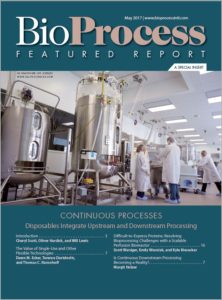 Continuous Processes: Disposables Integrate
Continuous Processes: Disposables Integrate
Upstream and Downstream Processing
Perhaps the “hottest” buzzwords in biomanufacturing today are continuous processing and single-use technologies. They are closely related — as one is increasingly enabled by the other. Perfusion and other approaches have begun to blur the line between upstream and downstream processing (by performing certain separation/clarification duties as part of their function). And separations technology suppliers are offering solutions to the challenge of continuous drug-substance purification. Alongside a review of these advancements by BPI’s senior technical editor, contributed articles expand on continuous upstream/production methods and continuous downstream processing technologies.
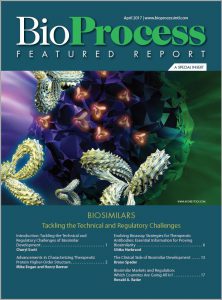 Biosimilars: Tackling the
Biosimilars: Tackling the
Technical and Regulatory Challenges
Biosimilar products have come about as a way to make biopharmaceuticals that are otherwise too costly available to a broader market. Like generic small-molecule drugs, they build on the success of licensed products. And although regulatory pathways allow biosimilar developers to bypass certain expensive testing, they are not generic drugs. Technical challenges remain a part of their development. This Featured Report contains an overview of those challenges and articles that dive into technologies that can help, regulatory hurdles that remain, and a look at the countries that are leading the way globally.
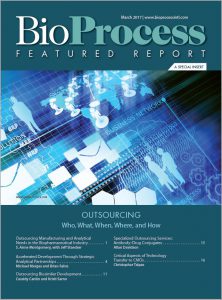 Biopharmaceutical Outsourcing:
Biopharmaceutical Outsourcing:
Who, What, When, Where, and Why?
Biopharmaceutical outsourcing has changed over the years. In this Featured Report the authors explore the increasing complexities of devising long-term business strategies, the importance of choosing between long-term partnerships or one-time/transaction-based projects; the assurance that adequate business support and technical capabilities exist on both sides of the relationships; and the criticality of navigating the uncertainties of working with different quality organizations. Issues that affect decisions to outsource include cost, converging quality systems, change management, and staff training/expertise (including statistical capabilities).
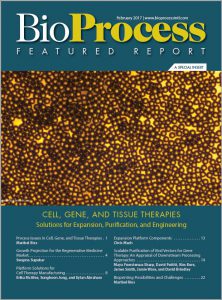 Cell, Gene, and Tissue Therapies:
Cell, Gene, and Tissue Therapies:
Solutions for Expansion, Purification, and Engineering
Cell therapy bioprocessing has advanced from limited efforts in specialized laboratories and academic institutions to becoming part of the mainstream biologics industry, with hundreds of companies involved and 20 product approvals in the United States (and more elsewhere). This featured report takes a snapshot of the processing issues of today — manufacturing platforms, purification of viral vectors for gene therapy, three-dimensional bioprinting — and looks toward the future of this biologics market segment.
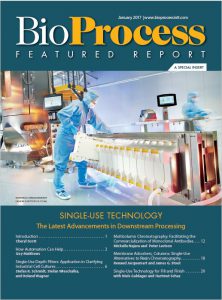 Single-Use Technology:
Single-Use Technology:
The Latest Advancements in Downstream Processing
As single-use technologies have grown in importance and acceptance, offering more solutions every year, their biggest challenges have come in downstream separation, purification, and processing that follows product expression in cell culture. Many technologies in downstream processing present technical and economic problems. Authors in this featured report delve into many of these issues and innovations. They discuss automation, depth filtration, continuous processing, alternatives to resin chromatography, and fill and finish technology.
View the complete BioProcess International archive for regular issues and supplements from 2002-2017.
